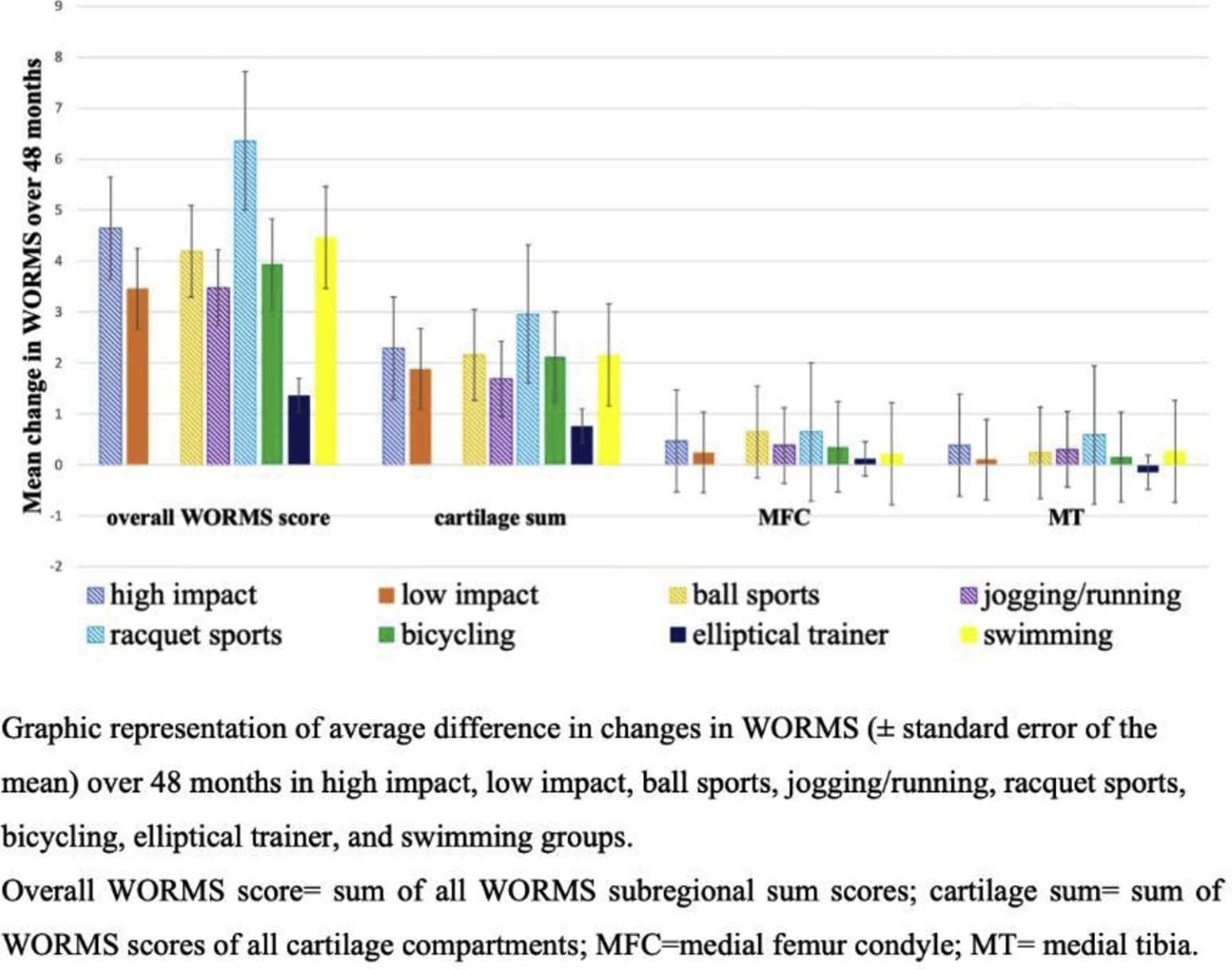Which types of physical activity are most beneficial for knee joint health in overweight and obese subjects? 48 months data from the osteoarthritis initiative
S. Schirò Osteoarthritis and Cartilage 28, SUPPLEMENT 1, S354-S355, APRIL 01, 2020
Purpose: Overweight and obese individuals are at higher risk for knee Osteoarthritis (OA) due to excessive knee joint load. The association between physical activity and knee OA, has not been systematically addressed in overweight and/or obese subjects and its association seems to be controversial. Therefore, the aims of this study were (i) to compare knee joint structural degeneration over 48-months in overweight and obese subjects without and with mild to moderate radiographic OA who performed high and low impact physical activities, and (ii) to assess the association of different types of physical activity with progression of degenerative changes, using semi-quantitative MRI-grading over a period of 48-months
Methods: Using the following inclusion criteria (i) BMI ≥ 25kg/ m2, (ii) Kellgren-Lawrence score ≤ 3 at baseline, (iii) no history of inflammatory arthropathies and (iv) MRI of the right knee available at baseline and at 48 months follow-up, a total of 415 subjects were studied from the Osteoarthritis Initiative (OAI) Cohort . Participants were categorized into the following physical activity groups: ball sports, bicycling, jogging/running, elliptical trainer, racquet sports and swimming based on their self-reported most frequent activity recorded at the 96 months visit. Activities were classified into high (ball sports, jogging/running and racquet sports) and low (bicycling, elliptical trainer and swimming) impact groups according to estimated intensity of joint impact and loading. Structural knee abnormalities were graded on 3T Magnetic Resonance Imaging (MRI) studies at baseline and 48 months, using Whole Organ Magnetic Resonance Imaging Scores (WORMS). Cartilage, menisci, ligaments, bone marrow edema pattern, subchondral cysts, effusion, loose bodies and popliteal cysts were graded. For each knee, sum scores were calculated by adding the features scores of each subregion and an overall WORMS score was obtained by adding these sum scores. Linear regression models were used to assess the differences in changes in WORMS features over 48 months between the high and low impact groups. In addition, linear regression models with Bonferroni correction were used to assess the differences in changes in WORMS features over 48 months between types of physical activity groups. All analyses were adjusted for age, race, sex and baseline BMI
Results: The mean age of participants was 59 years (SD ± 8.6), mean BMI was 30 kg/m2(SD ± 3.5) and 183/415 were women (44%).There were no significant differences in K/L score (p=0.965), age (p=0.885), BMI (p=0.069), ethnicity (p=0.185), between subjects in high and low physical activity groups. There was, however, a statistically significant difference in gender composition (p=<0.001). Among the six different types of physical activity groups, there were no significant differences in K/L score (p=0.507), age (p=0.426), BMI (p=0.426), ethnicity (p=0.099), with respect to the differences in gender composition (p=<0.001). Over 48 months the overall WORMS score increased significantly more in the high impact group compared to the low impact group (average difference in changes in WORMS score: 1.18 [95% CI]: [0.60, 2.30]; p=0.039). The overall WORMS score increased significantly more in the racquet sports group compared to the elliptical trainer group (4.98 [1.86,8.10]; p=<0.001) and the jogging/running group (2.88[0.42,5.33]; p=0.009), respectively. The cartilage sum score increased significantly more in participants in the racquet sports group compared to the participants in the elliptical trainer group (2.20 [0.59,3.81]; p=0.001), likewise there was a significant difference in the medial tibial cartilage compartment (0.73; [0.15,1.30];(p=0.003). The cartilage sum scores increased significantly more in participants in the racquet sports group compared to participants in the jogging and/or running group (1.26 [0.00,2.53]; p=0.050). No statistically significant differences were found comparing the other physical activity groups with each other
Conclusions: Our results suggest that high impact physical activity may increase structural knee joint degeneration in obese and overweight individuals. In particular, racquet sports were significantly associated with increased progression of overall knee joint degeneration and cartilage loss. On the other hand, elliptical trainer showed the smallest changes, and may be most beneficial for overall knee joint and cartilage health














